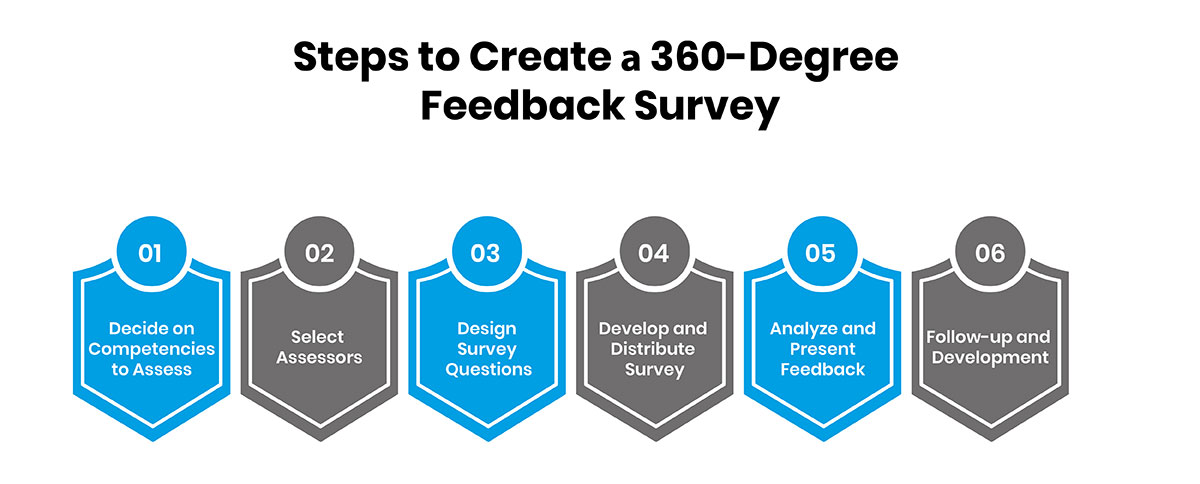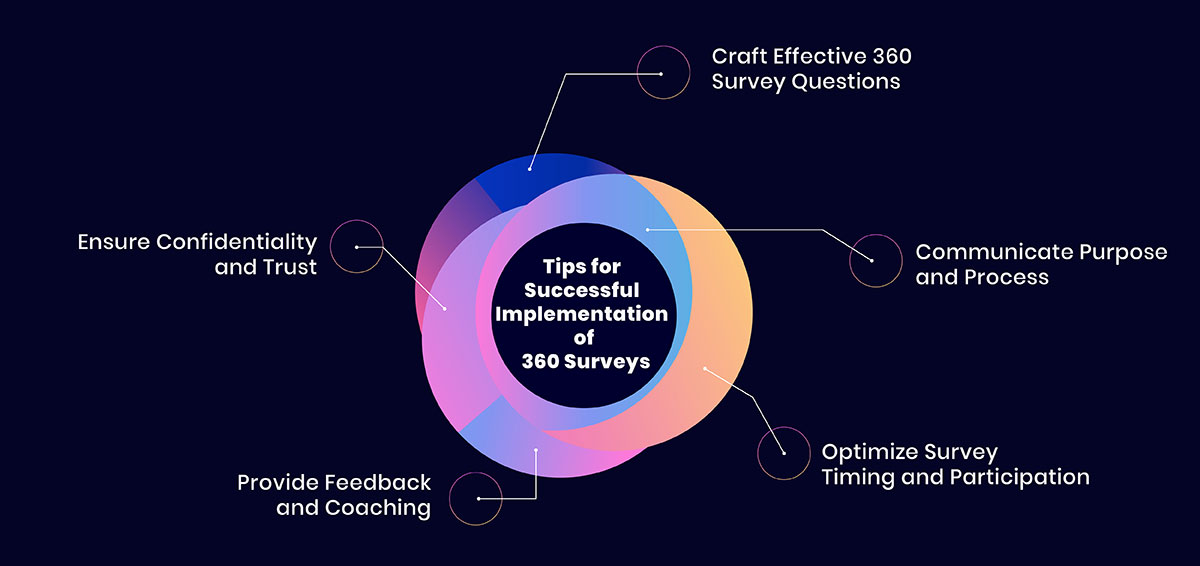
Conducting 360-degree feedback surveys is a fruitful way for organizations to gain a well-rounded view of an employee's performance beyond just traditional top-down evaluations. By tapping into perspectives from all reporting relationships, including managers, peers, direct reports, internal customers, and even external stakeholders, 360 reviews give employees crucial visibility into how their behaviors and actions are perceived across interactions. This holistic approach enables employees to pinpoint strengths to capitalize on as well as areas that need development.
When designed and implemented effectively, 360 surveys allow employees to step up into leadership roles by taking ownership of feedback and driving their self-improvement. Some key organizational benefits include enhanced employee engagement, stronger working relationships, and optimized performance by fostering an environment where everyone is willing to lend and receive feedback constructively.
This article will walk through a step-by-step guide to create and conduct an impactful 360-degree feedback survey. It will cover aspects like deciding competencies, selecting assessors, writing survey questions, distributing the tool, analyzing results, and enabling follow-through for continuous growth.
What is a 360-Degree Feedback Survey?
A 360-degree feedback survey refers to an evaluation system that solicits feedback on an individual employee, manager, or executive from people who work around them in all directions - their subordinates, peers, and supervisor/s. This comprehensive feedback aims to provide the employee or leader candid insights into how they are perceived in their role from multiple perspectives in the organization.
By garnering inputs from all angles, including reports, co-workers, and leadership, a 360-degree survey breaks away from the conventional top-down review structure and gives a well-rounded view of an individual's performance, leadership style, and intrapersonal skills. It helps take the employee's development a step further by revealing strengths as well as areas that need polishing, all of which they might not have insights into themselves.
While drafting such a survey, organizations must zero in on those key competencies and behaviors that truly matter for their people and business goals. Questions should be straightforward yet thought-provoking enough to elicit thoughtful feedback. Assessors are usually handpicked yet given the option to maintain anonymity to encourage honesty. Surveys are most often distributed via email to cast a wider net at low costs.
Once responses are in, one-on-one debrief sessions are scheduled where the employee, their reviews, and a set development plan are discussed. Periodic check-ins are also established to assess progress on action items over time. By giving and getting a rounded evaluations that are then leveraged for professional evolution, 360-degree surveys efficiently achieve their purpose of enhancing individual performance and optimizing organizational success.
When to Conduct a 360-degree Feedback?
Organizations carry out 360-degree feedback to translate their mission into specific employee goals and manage performance rather than simply reacting to it. Conducting regular 360-degree reviews allows a company to pinpoint overlapping duties, inefficiently utilized skills, completed work, and new ideas from staff, and ensure non-discrimination. It also reduces stress for both supervisors, who manage rather than react, and employees, who better understand expectations.
Feedback from multiple evaluators like direct reports, peers, customers, and managers provides a well-rounded view of an individual's strengths and weaknesses across different dimensions, including leadership, communication, work product, and teamwork. This comprehensive perspective is more insightful than assessments solely from superiors. Regular 360-degree reviews should be scheduled for all employees, especially those being considered for promotion or training opportunities.
How to Evaluate and Review 360-degree Feedback?
To effectively evaluate 360-degree feedback, organizations must first clearly establish the evaluation criteria. Evaluators rate the employee based on competencies directly tied to their role. A minimum of five evaluators is recommended to maintain anonymity while offering sufficient input. Immediate supervisors receive completed evaluations but do not evaluate direct reports to reduce bias.
Once compiled, supervisors analyze evaluations for patterns and inconsistencies. They detect skills requiring further improvement or confirmation of strengths compared to self-assessments. Discrepancies indicate the need for enhanced self-awareness. Consolidating evaluations quantifies performance across metrics visible to various stakeholders.
Follow-up involves supervisors meeting employees to discuss compiled feedback. Facilitated review sessions allow drilling down into comments to set explicit development goals. Employees receive unbiased input on behaviors affecting colleagues while supervisors pinpoint training enhancing team success. Organizations support goal achievement through recommended courses, mentorship, or on-the-job learning.
Periodic evaluation checks progress towards targets. Employees share accomplishments and persisting challenges. Supervisors recommend adjustments to maximize strengths. Reviewing evaluations over time shows growth in critical skills. It also holds employees and evaluation quality accountable. Organizations incentivizing development signal its importance to culture shift prioritizing learning.
A Step-by-Step Guide to Creating an Impactful 360-Degree Feedback Survey
The following are the steps to create a 360-degree feedback survey:

-
1.
Decide on Competencies to Assess
The first step is delineating the core competencies or dimensions that the organization values and wants feedback on. Examples of areas often covered are communication skills, collaboration abilities, leadership qualities, technical proficiency, and relationship management aptitude.
To pick relevant competencies, key stakeholders like the HR team should be involved in brainstorming sessions. Align the competencies to the employee's role profile and the wider strategic goals of their department or division. This ensures the competencies assessed truly represent target behaviors for success. Some roles may require additional dimensions like customer service orientation or innovation mindset, depending on their function.
-
2.
Select Assessors
Assessors are those providing feedback ratings and commentary on the employee's performance. Self-assessment by the employee is usually mandatory. Other potential assessors are:
-
Direct Manager: Provides a direct supervisor perspective on work quality and management. However, it may come across as biased.
-
Peers: Offer additional insights on collaboration styles and talents beyond what managers see. May need clear guidelines to avoid personal biases creeping in.
-
Direct Reports: For managers and above, this offers valuable perceptions of leadership effectiveness, communication skills, fostering team growth, etc.
The assessor pool can be customized per employee based on role and relationships. Ensure a balanced mix of assessments to overcome any undue skews from familiar assessor groups.
-
3.
Design Survey Questions
Well-crafted survey questions are key to eliciting meaningful, constructive feedback. Focus on competency-based behavioral questions starting with 'how' or 'to what extent' using verbs like demonstrate and exhibit. Avoid ambiguous questions with double negatives.
Keep questions concise yet allow for elaborative comments. A mix of quantitative rating scales and qualitative commentary yields richer insights. Opt for 5-point scales from 'needs improvement' to 'exceptional' or 'strongly disagree' to 'strongly agree'.
Request calibrated, thoughtful feedback rather than rushed answers by informing assessors of intended development use. Assure confidentiality to encourage honesty. Pilot test questions with a sample to refine.
-
4.
Develop and Distribute Survey
Leverage survey design platforms or software for an intuitive, user-friendly experience. Populate the template with details about the employee and assessor, core competencies, and tailored questions.
Consider email distribution for ease, yet leverage intranets or Learning Management Systems for authenticating assessors. Set a time frame of 2-4 weeks for responses. Send reminders without pressurizing to boost participation.
Respect assessors' time by avoiding excessive questions and allowing progress saves. Develop a custom assessment link for each assessor-employee pair to maintain anonymity. Provide guidance on descriptive feedback best practices.
-
5.
Analyze and Present Feedback
Survey responses must be assimilated into an actionable format for the employee. Statistical data on quantitative ratings presents the 'what'. The qualitative commentary provides the 'why' and 'how to improve'.
Pull out prevalent themes, strengths highlighted, and developmental areas identified across assessor groups. Look for performance disparities between self-assessment and others' views. Organize feedback themes under each assessed competency.
Schedule one-on-one sessions to discuss results, keeping the tone positive. Address any confusion, supplement incomplete areas, and thank assessors for their time. Seek employees' perspectives on results and agree on priorities for development.
-
6.
Follow-up and Development
Establish periodic check-ins, at minimum every 6 months, for the employee to report progress on development goals. Congratulate achievements and reassess areas still needing work.
Encourage continuous feedback-seeking beyond annual reviews. Suggest keeping assessment reports for reviewing growth over time. Consider multi-rater coaching if competency gaps exist. Recognize efforts to internalize feedback for true behavior change.
Leverage organizational resources like training programs, mentors, projects, and memberships to accelerate development. Tie accomplishments back to competencies initially assessed. Monitor impact on key metrics like quality, productivity, and relationships and incorporate learnings in future 360 processes.
Tools for 360-Degree Surveys
Purpose-built survey platforms are easy to implement with their library of templates and features. Example tools include:
-
SurveyMonkey: Intuitive admin console for all phases from design to distribution to analysis. Integrates with calendars.
-
Qualtrics: Robust customization options, skip logic, conditional questions. Exhaustive reporting suite and integration support.
While commercial tools optimize workflow, basic 360 surveys can even be set up through free Google Forms or Microsoft Forms for small teams. Choose an avenue that best meets the organization's security and budget needs.
Tips for successful implementation of 360 surveys
Here are some tips for the successful implementation of 360 surveys:

-
Craft Effective 360 Survey Questions
Carefully craft your 360 survey questions to thoroughly pick apart key competencies and job responsibilities. Make sure to fully flesh out the specific behaviors that exemplify stellar performance. Judiciously choose a rating scale that neatly captures subtle performance nuances. Reliably select assessors who holistically evaluate performance from diverse angles. Wisely allow rates to thoughtfully nominate some assessors to boost engagement. Skillfully pilot your 360 survey with a small group to surgically hone questions before wide-scale implementation.
-
Communicate Purpose and Process
Thoroughly communicate the purpose and process of 360 surveys to clearly set expectations. Repeat as necessary to deeply drive home that feedback seeks development, not judgment. Emphasize anonymity to smoothly alleviate rating fears. Stress development over evaluation to readily gain honest, helpful responses. Actively involve human resources to deftly address any issues and guide the process. Adequately train those analyzing results on meaningfully discussing feedback and crafting action plans.
-
Optimize Survey Timing and Participation
Carefully calculate the timing for optimal survey completion rates. Artfully juggle workloads and schedules to reasonably engage participants. Flexibly allow extensions for major deadlines or crunch periods. Gradually phase larger rollouts to gradually work out early kinks. Consistent follow-up on non-respondents is needed to capture all perspectives fully. Innovatively incent participation through recognition or time-off to creatively boost involvement.
-
Provide Feedback and Coaching
Thoughtfully provide feedback recipients coaching on effectively processing results. Show how to methodically parse through comments and quantitatively analyze trends. Guide distinction between performance perceptions versus actual abilities. Demonstrate transformation of insights into achievable development goals. Continuously check in on progress to fundamentally hold accountability. Gradually expand participation over time to comprehensively strengthen the impact.
-
Ensure Confidentiality and Trust
Fundamentally uphold confidentiality and discreetly handle all feedback to engender trust. Judiciously prevent assessor identification to candidly collect honest perspectives. Prudently withhold feedback distribution until fully deidentifying responses. Reserve final say for rates on sharing report details. Defensibly address any violations to diligently protect the process. Repeated over time, multilaterally drive performance growth through rich developmental conversations powered by 360 surveys.
Conclusion
In conclusion, 360-degree feedback surveys are a powerful developmental intervention when administered mindfully with an emphasis on growth over judgment. By considering all stakeholder perspectives and surfacing blindspots, organizations can help individuals upskill strategically through feedback and coaching. Regular practice makes 360 processes ingrained in the culture as an opportunity rather than an annual chore while continuously maximizing human potential.




